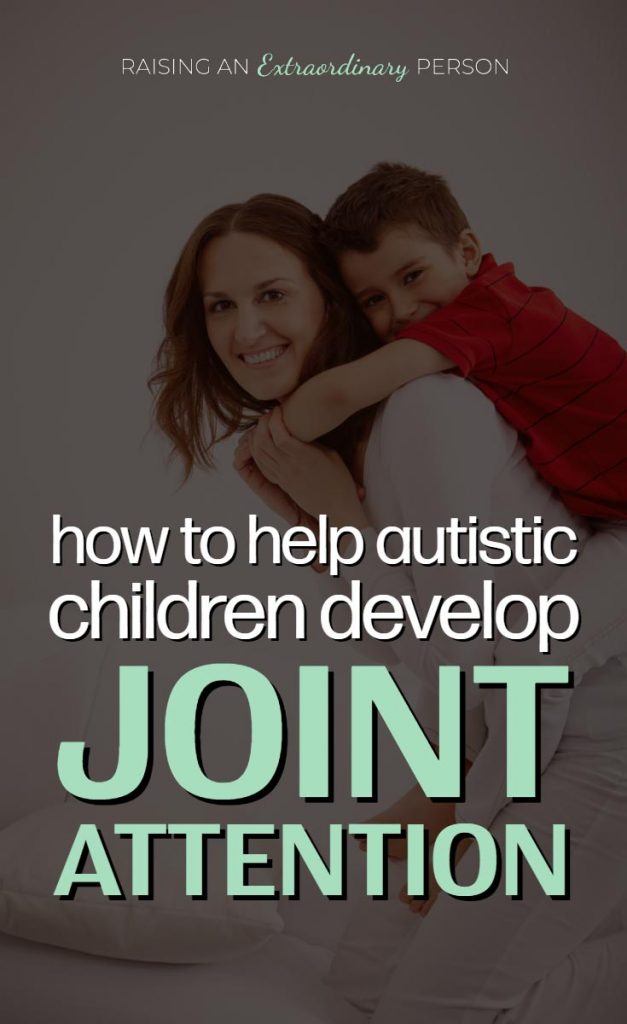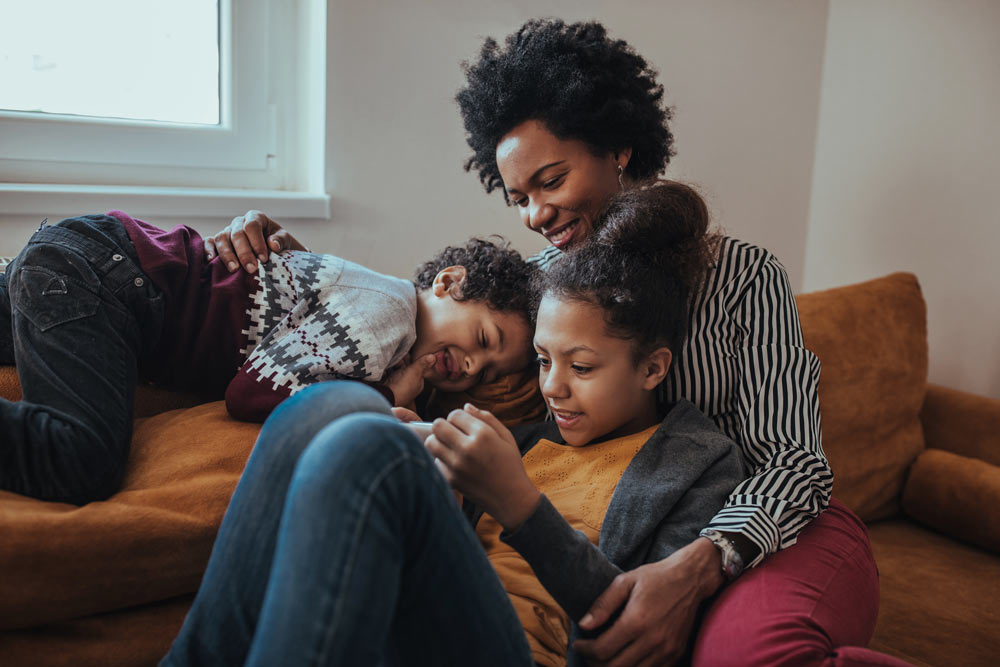Joint Attention and Autism
What’s inside this article: Information about joint attention that is easy for parents to understand. Includes examples of joint attention, a list of joint attention skills, and strategies and games that can help build their social skill.
Disclaimer: This post contains affiliate links.
If your child struggles with communication and social skills, you may hear the term “joint attention” mentioned by their SLP or psychologist, or perhaps special educator.
Since joint attention is important when developing social skills, it’s helpful to understand what it means, what the milestones are when developing joint attention, and which strategies can help your child.
Joint attention is very social in nature so it doesn’t come as a surprise that this skill is often lagging in children with autism.
Joint attention is when two people share an interest in something – this could be an object, an event, a topic of interest – and there is an understanding that both people are interested. It means you can have a mutually enjoyable social exchange.
Examples of Joint Attention:
- Enjoying a book together
- Playing a board game
- Talking about an upcoming event that both people are attending
- Showing off artwork or a toy to another peer because they think they will also like it
- Asking questions to learn more about the other person
Joint Attention is Not:
- Asking for something they want
- Asking for permission to do something
- Playing with toys while you read them a book
- Sitting beside another child while both engage in their own independent activities
The reason it is not any of those things is that those types of interactions or activities are not social in nature and not a mutually engaging interaction.

Developmental Milestones of Joint Attention
In a typically developing child, joint attention starts emerging at around 9-12 months. One of the first games played by babies that require joint attention peek-a-boo.
Parents who aren’t seeing any signs of joint attention by 18 months old should definitely bring their concerns to their child’s doctor because it may be a sign of autism.
These are the developmental milestones of joint attention, as listed in The SCERTS Model: A Comprehensive Educational Approach For Children With Autism Spectrum Disorders.
List of Joint Attention Skills:
- Monitors the attention of a social partner. So, they can identify if they appear interested or uninterested during a conversation.
- Secures attention to oneself before expressing intentions. This may be done by gently tapping the other person’s arm, saying their name, etc.
- Understands nonverbal cues to shift the focus when conversing with a social partner
- Modifies language based on what their social partner has seen or heard. For example, they wouldn’t tell their mom what was in their lunch box because they understand that their mom packed the lunch for them and already knows what’s inside.
- Shares internal thoughts or mental plans with a social partner. For example, tells a friend “After school, I’m going to the park”
- Provides requested information about immediate and past events, when asked.
- Expresses feelings and opinions about a variety of topics
- Shows reciprocity in speaker and listener roles sharing experiences. In other words, both parties share information and focus on what their social partner shares.
- Initiates a variety of conversational topics
- Initiates and maintains conversations that relate to their social partners’ interests
- Maintains social interactions by requesting or providing relevant information. For example, if someone says they read a book over the weekend, your child can maintain the interaction by asking questions like “what book did you read?” or “did you like it?”
- Provides relevant information based on social partners’ knowledge of a topic
- Gauges length and content of conversational turn based on partners’. In other words, they can judge how much information to share and how long to talk based on how much information was shared by the social partner.
- Prefers spending time engaging with others as opposed to being alone
- Has friendships with partners who share similar interests as they do
- Repeats and modifies communication to repair breakdowns. This means if their social partner didn’t understand what they meant they will reword in order to clarify their message.
- Recognizes breakdowns in communication and requests clarification if needed. This means if they don’t understand what another person said they will ask for clarification.
- Modifies language and behavior based on partners change in agenda
- Modifies language and behavior based on partners emotional reaction
- Expresses feelings of success and confidence during social interactions
Note:
Some of these social skills are very advanced and you should not expect a young child to be able to do everything on this list. However, you should be seeing these skills emerge or your child attempting them in some way, even if they aren’t successful.
Eye Contact
One very common component of joint attention in neurotypicals is making eye contact with their social partner. It shows the other person that you’re listening, it helps you read their emotions and intentions.
However, eye contact is often very uncomfortable and even described as painful for some autistic individuals. Some clinicians and therapists believe forcing eye contact should be a part of the treatment for someone with autism.
But – research is showing us with more and more certainty that forcing eye contact may do more harm than good. Keep this in mind when you or anyone is communicating with your child. Eye contact is certainly not the most important thing in social interactions. You don’t need eye contact to have joint attention.
What’s important is that your child is listening, understanding, and engaging.
Strategies for Joint Attention

There are various therapeutic options available for developing joint attention in autistic children but it’s important to remember that true joint attention only occurs when both parties are truly interested in and want to pay attention to, the same thing.
DIR Floortime
DIR floortime is a play-based therapy for children. Parents can take the concepts of floortime and apply them at home without too much difficulty.
Research shows that this method helps improve social skills and engagement, along with symbolic and logical thinking skills in autistic children.
Learn more about DIR floortime here.
Do Engaging Activities
If your child struggles with joint attention, before you’ll have any success with getting them to engage in other people’s interests, you first need them to show joint attention when focusing on their own interests.
Do this by creating and participating in sensory-friendly, open-ended activities that include their special interests. This may be things like using play-doh, or popping bubbles together. Or, it could involve building Star Wars lego together, playing a Pokemon themed board game, two-player mode on their favorite video games, etc.
Make Small Bids for Their Attention
Autistic children usually find responding to a bid for joint attention is easier than initiating an interaction. Take the time to make small bids for your child’s attention and see if they engage.
Success doesn’t mean your child will take part in a long bath and forth conversation about their school day or a book they read. In fact, it’s about the small things.
For example, saying “Hey! Look at that car!” when you spot a fancy sportscar or an antique truck on your way to school. Does your child follow your gaze to see the car? That is a brief moment of joint attention!
Sharing these small moments together frequently will help your child develop joint attention.
Joint Attention Games & Activities
School-aged children with autism may understand the idea of joint attention. In other words, they know they are supposed to ask other people about their interests or carry out a back and forth conversation. But, they may not know how to actually participate in that type of interaction on their own.
Practicing these skills through games, direct coaching, and social stories may help develop this skill.
These games and activities can help kids practice these conversation skills so it’s easier to know what to say when conversing with a social partner.
- All About Me, All About You: Conversation cards help children develop social skills and learn how to ask open-ended questions to others during conversation.
- Topic Talk: This game helps kids learn about asking questions, making comments and making related comments in response to their social partner’s comment.
- Table Topics: Fun questions to start interesting conversations for kids.
- Kloog 2 – Social Skills for Autism: This is a completely free app available on iOS and Android, developed by the Shine Autism Center. It’s a game that follows the journey of an alien named Kloog who has to work through various challenging social situations on different planets.
More on Communication Skills
Communication challenges are part of the diagnostic criteria of Autism Spectrum Disorder in the DSM V. It covers a broad range of abilities from verbal language, symbolic communication, listening skills, social skills, pragmatics, joint attention, and more.
Each child has their own unique challenges, and strengths.

